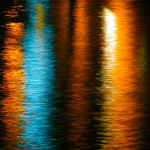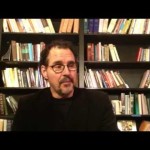We run our website the way we wished the whole internet worked: we provide high quality original content with no ads. We are funded solely by your direct support. Please consider supporting this project.

When Our Images of God are Faulty
I’m fleshing out the third proclamation of the ReKnew Manifesto, which challenges us to rethink our conception of God. In the previous post I noted that, since our relationship with God is mediated through our mental picture of him, our image completely determines how we feel about God and what our relationship with him will be like.
It’s no wonder that the first thing Satan attacked when tempting Eve in the Garden of Eden was her picture of God. Here’s how I interpret its depiction in the biblical narrative (Gen.3:1-5).
Out of love God placed the “Tree of the Knowledge of Good and Evil” in the Garden. As I argue in my book Repenting of Religion, this was God’s loving “No Trespassing” sign reminding Adam and Eve – and all of us — that we should never imagine we have the right or the capacity to judge others by our standards of “good” and “evil.” If we’re going to love like God loves – which is, I argue, the ultimate point of everything – we must always remember that God alone is the judge of the world. Unlike God, we can’t love and judge at the same time.
As he always does, Satan took God’s loving act and gave it his own diabolic spin. He told Eve that the reason God forbid her eating from the tree was because, “God knows that when you eat of it your eyes will be opened, and you will be like God, knowing good and evil” (Gen. 3:5). Satan painted a petty and untrustworthy picture of God. He made it seem like God was threatened by the potential the forbidden tree offered Eve.
Tragically, Eve believed the lie. Since her picture of God was no longer trustworthy, she stopped trusting God. Consequently, she felt she was on her own to become all she could be. So she violated God’s “No Trespassing Sign” and ate from the tree. And, as the saying goes, the rest is history.
However literal or figurative you interpret this narrative, its timeless teaching is that behind all human rebellion and sin is a faulty picture of God. As I discussed regarding the first proclamation of the ReKnew Manifesto, we are created with a vacuum in our soul that only God can fulfill. At the core of our being we crave a fullness of love, worth, significance and security that only our Creator can give. We have a hunger for fullness of LIFE, and it never goes away except insofar as we have a surrendered relationship to the one who is himself LIFE. All the beautiful plans God has for humans depend on our getting LIFE from God and God alone. Everything we are created to do is meant to be an expression of the LIFE we receive from God for free.
The trouble is, if we embrace an untrustworthy mental picture of God, we cannot enter into a LIFE-giving relationship with him. Consequently, our souls can’t help but crave LIFE, so we invariably try to get LIFE for ourselves on the basis of the things we accomplish, the possessions we acquire, the applause we get from others, the pleasures we experience, and so on. The Bible calls all such attempts to acquire LIFE “idolatry,” and it lies at the root of all sin.
The only way to get free of idolatry, and the only way to be empowered to love the way Jesus modeled for us to love, is to get all of our LIFE from God. And the only way we can do this is if we have an accurate, trustworthy, beautiful mental picture of God.
Everything God created us to be depends on the beauty and accuracy of your mental picture of God. So now the all-important question becomes: what authority do you trust to reveal to you what God is really like? The standard answer that Evangelicals give is, “the Bible.” In the next several blogs, I’m going to argue that this response is, at best, only partly correct.
Image by Elena Lagaria. Used in accordance with Creative Commons. Sourced via Flickr.
Category: General
Tags: Adam and Eve, Imagination, Picture of God, ReKnew
Related Reading

Our Commitment to Love (and Avoiding Theological Idolatry)
Given that we have just launched ReKnew, I thought it would be helpful to spend a good portion of our initial blogs unpacking the theological vision of ReKnew. Our goal is to post content to the site at least three or four times a week, with two of these posts (on average) being fresh content from me addressing particular theological topics. The other posts will be things such as videos, quotes of the day, featured articles from elsewhere on the web questions from readers, and so on.
Before I begin unpacking ReKnew’s theological vision in subsequent posts, however, today I want to offer four preliminary words about the theological convictions I’ll be espousing.

Who You Are Reflects the Kind of God You Worship
We always reflect the mental picture of God that we envision, for better or worse. If you have a fear-based picture of God, it will even affect the structure of your brain. You become the kind of person that you worship. If you have a threatening picture of God, you become threatening. If you have a…

Reflections on the Supremacy of Christ (Part 1)
In my previous post I argued that the Bible tells a story in which the culminating event – the coming of Christ – reframes everything that preceded it. Though it is all inspired, not everything in it should carry equal weight for us. Rather, everything leading up to Christ, including the portraits of God, must…

The Image of God
Distorted from digma.com Is the image of God you hold in your heart one that attracts or repels you?

A Book That Won’t Leave You Unchanged
St. Ignatius of Loyola, the 16th century founder of the Jesuits, taught that to experience the transforming power of Scripture, we need to read it “with all five senses,” using our imagination to get on the inside of the characters and story we’re reading about. A just-released book by Frank Viola and MaryDeMuth entitled “The…

Why Bart Ehrman Doesn’t Have to Ruin Your Christmas (Or Your Faith) Part 1
This is the first of several videos Greg put together to refute Bart Ehrman’s claims published in the article What Do We Really Know About Jesus? Greg went to school with Bart and is very familiar with his line of thought. He’s also heard of many people who have lost their faith based on his writings.…
